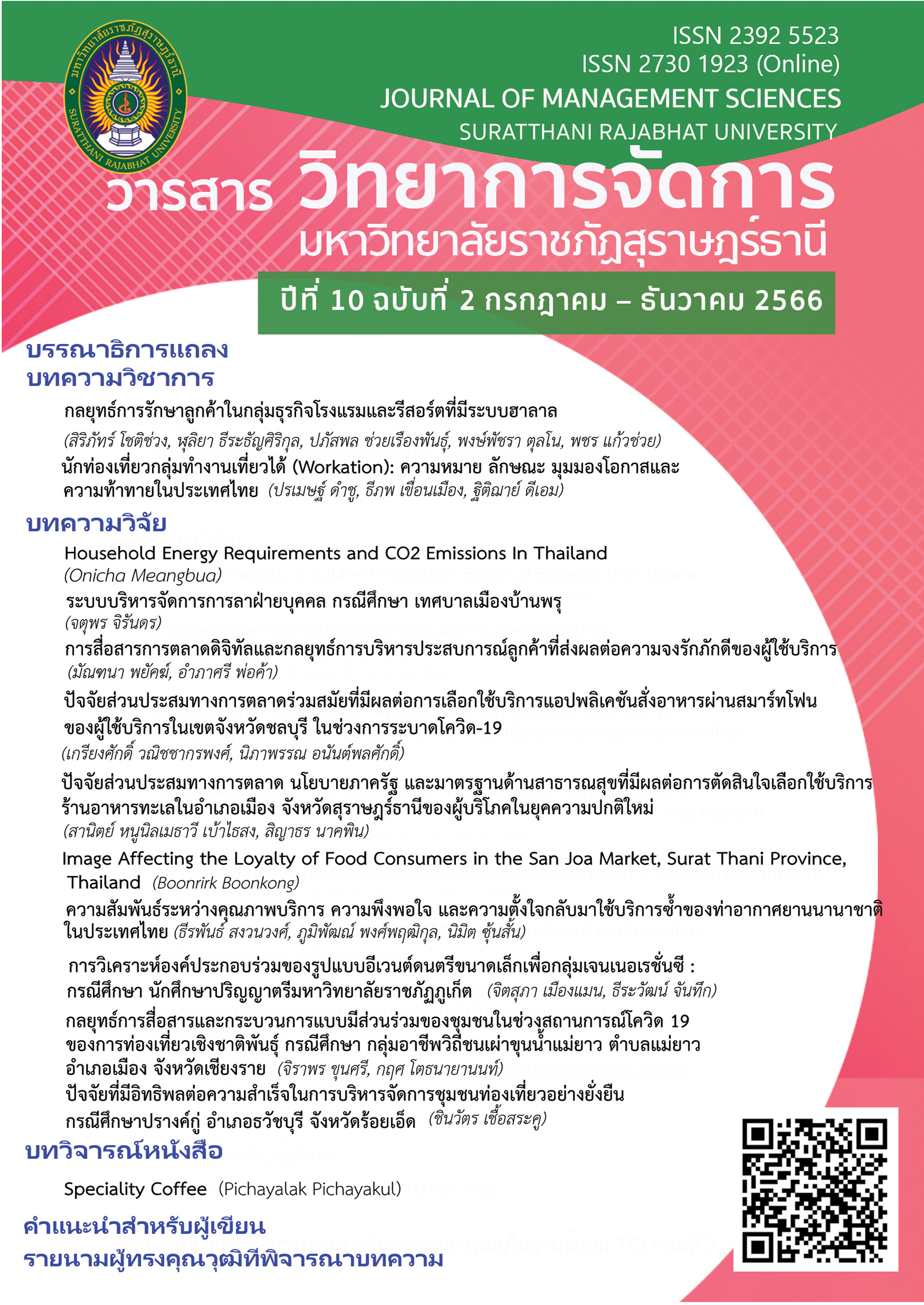Factors Influencing Success of Implementation in Management of Sustainable Tourism Community: A Case Study of Prang Ku, Thawat Buri District, Roi Et Province
Main Article Content
Abstract
Besides the natural resources that generate money and attract both domestic and foreign tourists into Thailand, ancient and religious sites can add economic value simultaneously for the tourism industry in Thailand,. Cultural tourism that allows people in the community to participate in management is a component in the concept of sustainable development. How can community-based tourism be elevated to a higher level of fame? Theis paper’s objectives were to: 1) study level of the importance of casual factors that leading the attraction of Prang Ku’s tourism; 2) study the level of the success dimensions of tourism community management; 3) study the relationship among casual factor dimensions that lead the attraction of Prang Ku and the success dimensions of tourism community management. 293 respondents were obtained from 2 villages around the area. The questionnaires and statistics used in the research were mean, standard deviation. t-test, F-test and Multiple Linear Regression. The statistic results revealed that: 1) worthy features in villagers' perceptions were observed in high value. 2) The overall opinion on the success of Prang Ku tourist attraction management was at a high level. 3) All desirable characteristics positively influence the success of tourism community management at the 0.05 level, where the dimension of cooperation among villager is the factor with the best influence on tourism community management. Policy recommendations include that relevant departments use proactive, bilingual, and third-language media, there should be a budget to visit cultural attractions in other provinces or regions and network partners should be created in each area to be able to sell or exchange community products between them.
Article Details

This work is licensed under a Creative Commons Attribution-NonCommercial-NoDerivatives 4.0 International License.
References
Ariyanon, K. (2009). A participatory action research for sustainable tourism development through environmental education process: a case study of sirindhorn international environmental park. Bangkok: Mahidol University.
Belkadi, F., Bonjour, E., Camargo, M. Troussier, N., & Eynard, B. (2013). A situation model to support awareness in collaborative design. International Journal of Human-Computer Studies, 71(1), 110-129.
Best, J., & Kahn, J. V. (1993). Research in Education (7th ed.). Boston: Allyn and Bacon.
Bywater, M. (1993). The Market for Cultural Tourism in Europe. Travel and Tourism Analyst, 6, 30-46.
Emphandhu, D. (2007). Community-based tourism development and homestay activities. Bangkok: Kasetsart University.
Inpuwa, R., & Nawaluck, N. (2019). The roles of Public Participation in the conservation of cultural tourism: a case study of Nahon Phanom Province. Ramkhamhaeng Research Journal, 22 (2), 73–83.
Jittangwattan, B. (2007). Sustainable tourism development (2nd edition). Bangkok: Press and Design.
Kaewsuriya. (2006). Guidelines for the tourism in 21st Century. Bangkok: Dhurakij Pundit University.
Kasetsiri, C. (1997). Cultural Tourism. Bangkok: Amarin Printing.
Kongtong, P., & Namwong, S. (2016). Factors Affecting the Success of Cultural Tourism Destination Development of Nakhon Si Thammarat Province. Journal of International and Thai Tourism, 12(2). 1-33.
Pinsri, K. (2008). A Study of the Potential of Lan-Chang Culture Sites in The Lower Northeastern Part of Thailand for Cultural. Bangkok: The Thailand Research Fund.
Pongnirundorn, S., Buatham, O., & Yodsuwan, C. (2016). Guidelines for Effective Development in Tourism Management of Wang Nam Khiao District, NakhonRatchasima Province. MBA-KKU Journal, 9(1). 234-259.
Rudee, S. (2020). Promotion Strategy For Community Based Tourism. Journal of Multidisciplinary Academic Research and Development, 2(4), 51-61.
Siriprpa, P. (2019). Development of tourism public relations media using community-based concepts. [Master of Science thesis] Mahasarakham: Mahasarakham University.
Srisawat, C. (2008). The Cultural Tour: A case Study Khui's Culture in The Lower Northeastern Part of Thailand and South Laos. Bangkok: The Thailand Research Fund.
Suansri, P., & Yeejoho, S. (2013). Community based tourism handbook. Chiang Mai: Wanida Karnpim Limited Partnership.
Supitchaya, B., & Wijittra, S. (2017). The peoples participation in cultural tourism of Chiangkhan community, Chiangkhan district, Loei province. Research and Development Journal Loei Rajabhat University, 12(40), 75-84.
Thanut, W. (2020). Factors Affected the Strength of Nawatwithi OTOP Tourism Community in Nakhon Ratchasima Province. NEU Academic and Research Journal, 9(2), 71-80.
The Association of Domestic Travel. (2022). Sustainable Tourism https://www.adt.or.th/page/sustainable-tourism/en.
The Thailand Community Based Tourism Institute. (2017). The benefits that the community receives. www.cbti.or.th/?ge=show_pages&gen_lang= 20112012094103#.Wn291byWaM8.
Thuedom, N. (2008). Management of Museum Ancient remains Religions places to become culturally sustainable tourism site. Bangkok: The Thailand Research Fund.
United Nations World Tourism Organization. (2005). Tourism Highlights. https://www.eunwto.org/doi/book/10.18111/9789284411900.
Wisit, Y., & Ausanakorn, T. (2020). Factors Contributing to Community Strength of Village Models for Sufficiency Economy, Amphoe Koh Chan, Chonburi Province. The Journal of Faculty of Applied Arts, 11(1). 39-50.
Witaeak, S., Orawan, C., Wiyada, L., & Kanyarut, C. (2023). The Lesson Learned to enhance potential of creative community-based tourism based on local identity. Panyapiwat Journal, 15(2), 164-176.
Wiwat, J., Korkaew, J, Chutima, W. ,Duangrudee, U., & Nisachon, S. (2020). Tourist Satisfaction in Songkhla Community Tourism. The 11th Hatyai National and International Conference, 1782 – 1797.


